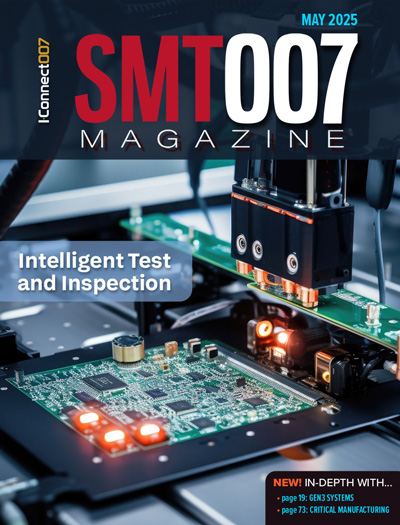-

-
News
News Highlights
- Books
Featured Books
- smt007 Magazine
Latest Issues
Current Issue
What's Your Sweet Spot?
Are you in a niche that’s growing or shrinking? Is it time to reassess and refocus? We spotlight companies thriving by redefining or reinforcing their niche. What are their insights?

Moving Forward With Confidence
In this issue, we focus on sales and quoting, workforce training, new IPC leadership in the U.S. and Canada, the effects of tariffs, CFX standards, and much more—all designed to provide perspective as you move through the cloud bank of today's shifting economic market.

Intelligent Test and Inspection
Are you ready to explore the cutting-edge advancements shaping the electronics manufacturing industry? The May 2025 issue of SMT007 Magazine is packed with insights, innovations, and expert perspectives that you won’t want to miss.
- Articles
- Columns
- Links
- Media kit
||| MENU - smt007 Magazine
Understanding EMS Pricing Strategies
December 31, 1969 |Estimated reading time: 3 minutes
While pricing pressures continue to strain developers and manufacturers, the business model is in need of repair. How will companies succeed through these challenges?
By Jennifer Read
As consumers of a bountiful harvest of low-cost electronics products, we benefit from the downward pricing pressure the industry is experiencing. But those trying to make a living developing and manufacturing these products - OEMs, EMS providers and Original Design Manufacturing (ODM) suppliers, as well as those companies providing components and materials, may conclude that the current business model is in need of repair.
Technology Forecasters’ (TFI) most recent five-year forecast predicts total annual revenues for EMS manufacturing will nearly double. Clearly, some companies participating in this healthy growth will perform better for their stakeholders than others. In fact, it would be reasonable to assume that some companies doing business now will not be doing business in 2009, while others will prosper. How will the successful manage through these challenging times?
We believe one of the strategic levers both OEMs and their EMS/ODM suppliers need to monitor is manufacturing services pricing. Our research reveals that the industry has struggled with managing this process effectively, and that significant upside exists for companies who discover and implement the right methodology.
On the OEM side, there is confusion and mistrust of the way contract manufacturers price their services, often leading to miscommunication and misalignment of business objectives. One example is a cell phone company’s recently publicized price-masking initiative, whereby the company pulled all price negotiations with suppliers in-house and away from its contract manufacturers in an attempt to better control supply-chain costs.
In virtually every EMS industry survey conducted over the past ten years, “pricing” has been listed as one of the top five concerns of OEMs. To address this concern, EMS companies have expanded their operating footprints to include capabilities in virtually all low-cost geographies around the world. While the cost of labor is an important factor in assessing these global alternatives, it is one element of pricing, and historically has been a poor indicator of “total cost of ownership”.
One of the tools available to assist OEMs with this activity is TFI’s Global Pricing Workshop (GPW). TFI conducted ‘blind’ interviews with several mid-sized and smaller contract manufacturers, ODMs and design-services providers from more than a dozen countries, and aggregated and compiled this data. The resulting tool enables our clients to analyze the true costs associated with outsourcing a particular assembly in a particular region.
An industrial equipment manufacturer was considering the use of a contract manufacturer in China, based on an incomplete and inaccurate analysis of manufacturing services costs. However, after using this tool, they elected to work with a facility in Mexico instead, and have been pleased. They now have a better understanding of their true cost of ownership and are re-evaluating a number of other assembly solutions they have in other parts of the world.
OEMs considering outsourcing to various regions should ask:
- What do EMS providers and ODMs include in their prices?
- What do labor and overhead cost?
- How are prices (including mark-ups) determined?
- How can I use this information to reduce the cost of my product?
- Where is the most cost-effective region to build my product?
- How do I determine my total cost of ownership?
Because nearly 100 OEMs have attended the Global Pricing Workshops, contract manufacturers or ODMs who learn about and align themselves with this methodology gain insight into working with OEMs - especially with geographic selections. They can also use this knowledge to optimize their service offerings, saving time and cost. By knowing what questions OEMs are asking about total costs, service providers can become more pro-active and responsive with their customers. An additional side benefit is less misinformation and re-established trust between parties.
Conclusion
The industry continues to move forward, beyond the requirements that stimulated the dramatic growth of outsourcing in the first place. As the requirements of this volatile industry become even more stringent, and pricing pressures from globalization increase, new tools and approaches will continue to give the competitive advantage to industry front-runners. Companies that seek out new toolsets in support of this evolutionary process may be the ones who end up being the winners in 2009, providing the most growth for their stakeholders.
Jennifer Read, director of client services, Technology Forecasters Inc., may be contacted at (623) 293-6985; e-mail: jread@techforecasters.com.


